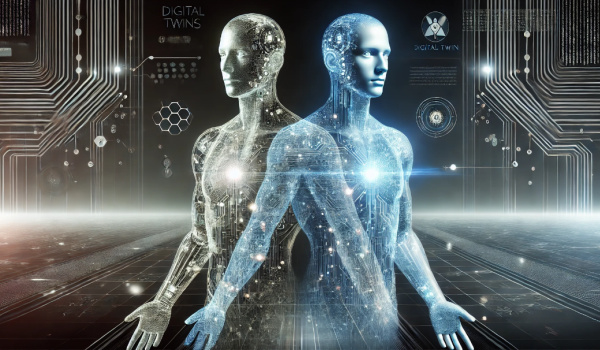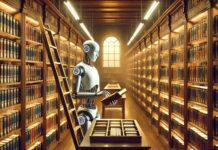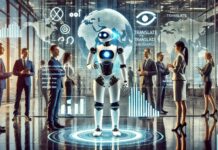Each week we find a new topic for our readers to learn about in our AI Education column.
Part of the power of artificial intelligence technology is that it can learn over time—AI is capable of improving itself as it does more work. But as AI proliferates in more key areas of the global economy, like finance and health care, technologists encounter obstacles to “teaching” the technology.
How do you train artificial intelligence in health care applications without putting someone’s health at risk? How can financial institutions create their own AI-infused services without putting their clients at risk as they train the technology?
The answer is digital twins, which have become central to the implementation of AI in industries like manufacturing, transportation and construction.
What Are Digital Twins?
A digital twin is “a virtual representation of real-world entities, like people or objects, and processes, synchronized at a specified frequency and fidelity,” according to the Digital Twin Consortium. A digital twin uses real-time and historical data to represent the past and present, and to simulate what might happen during predicted futures.
A digital twin is not a simulation—it’s more like a system of simulations designed around an object, person or process. While a simulation studies a single system, a digital twin studies an object or person’s interactions within an environment of systems. Unlike simulations, digital twin studies can evolve as a digital twin reacts to the environment and vice versa.
Digital twins can be relatively simple units and components or highly complex systems and processes. Highly complex digital twin systems that replicate entire people, environments, or populations are often built using less complex digital twin units as components.
Where Did Digital Twins Come From?
The concept of a digital twin, an accurate digital representation of a physical person or object, has been around conceptually for more than 30 years, and it existed as a concept for many years before the technology existed to make it a reality—and digital twins have only recently become practical for all but the largest companies and wealthiest public enterprises.
Digital twins were first formally defined by NASA in 2010 as the agency tried to make a better spacecraft and needed better model representations of a craft moving through different physical conditions, the impact on onboard systems, and the impact on crew and payload.
Today, digital twins are actively used across the economy to create better products and processes. Digital twins are a reality.
Where Does AI Come In?
Artificial intelligence is related to digital twin technology in two ways. One, artificial intelligence technology usually drives the input, response and feedback within digital twins.
A digital twin is made by first using sensors and computers to replicate the various systems comprising an entity and with which an entity interacts. So, if we’re making a digital twin of a vehicle, we would want to understand how the vehicle is propelled, the surfaces hand substances it moves upon and through—and how they change, how its weight and shape changes over time, how it decelerates—and whether it reclaims some or all of the kinetic energy from deceleration, how its cargo and crew shift and change within its shape, and a whole host of other variables.
If we’re making a digital twin of a physical person for a health care application, we would want to use similar technology to record and track that person’s metabolic functions and other health markers in order to build our digital twin. We could create a unit digital twin for our mitral heart valve, which would work in a system digital twin of our heart along unit digital twins for our aortic, pulmonary and tricuspid valves, atria and ventricles, as well as electrophysical components like the AV and SA nodes. This heart system digital twin would be part of a larger cardio-pulmonary-circulatory system digital twin, which would be part of that person’s process twin.
All of this data is used to create an accurate digital copy of a real-life person or object within digital representations of the real-life systems that person or object exists within.
What Digital Twins Are Used For
Digital twins feed back into AI technology by creating models and environments within which to test and train artificial intelligences. While they are not themselves similations, digital twins can be used to create simulations within which creators can analyze problems and test enhancements as close to “in situ” as possible without putting at risk a real person or entity.
Using our health care digital twin, for example, we can test the potential outcomes of different health care interventions, from different drugs, to electrophysical procedures like cardiac ablation, to more conventional surgeries. We could use our personalized digital twin to optimize and personalize treatments to try to find the best possible outcome for the individual patient.
Digital twins allow manufacturers to conduct more effective research into not just products, but processes used to create and enhance products ideally to help creators make the best product using the best possible process. During production, digital twins can still be helpful to help discover and implement efficiencies across processes.
Digital twins can also help understand what becomes of a product at end-of-life.
Where Are the Digital Twins?
Though we might not be aware of them, digital twins are already being used all around us. They’re already extensively implemented in transportation, construction, power and energy and manufacturing uses, where they’ve found particular utility in their ability to help companies optimize processes.
Emerging applications include growing interest in uses within health care and also within city planning.
In the future, digital twin technology will see further implementation within the financial sector, where companies are already starting to offer it as a method to test new and different types of fintech that might otherwise be disruptive to clients, a business’s operations, or to key financial systems. It will also find greater use in agriculture and food, to help create more efficient farming, production and distribution systems
Like all emerging technologies, it’s hard to imagine that the retail industry won’t find a way to use digital twins to help create better customer experiences and help them sell more products. We’re of the opinion that retail eventually adopts anything and everything when the price is right.
The internet of things—the rise of sensors and computers and real-time data in everyday technologies within the home and business—will feed directly into the development of more personalized and individualized digital twins not just for our own use within our homes and workplaces, but to help companies create better products for us and more effective methods of selling them.
When it’s all said and done, we, the people, might be the most promising application of digital twins.







